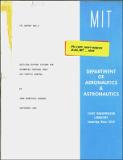| dc.contributor.author | Pararas, John Demetrios | en_US |
| dc.contributor.other | Massachusetts Institute of Technology. Flight Transportation Laboratory | en_US |
| dc.date.accessioned | 2012-01-06T22:05:08Z | |
| dc.date.available | 2012-01-06T22:05:08Z | |
| dc.date.issued | 1982 | en_US |
| dc.identifier | 13195053 | en_US |
| dc.identifier.uri | http://hdl.handle.net/1721.1/68057 | |
| dc.description | Also issued as a Ph. D. thesis, Massachusetts Institute of Technology, Dept. of Aeronautics and Astronautics, 1982 | en_US |
| dc.description | September 1982 | en_US |
| dc.description | Includes bibliographical references (p. 233-237) | en_US |
| dc.description.abstract | This work studies the automation of the terminal area Air Traffic Management and Control (ATM/C) system. The ATM/C decision-making process is analyzed and broken down into a number of "automation functions". Each of these functions is described with particular emphasis on its role in the overall system and its interactions with the other ATM/C automation functions. Runway Scheduling and Traffic Flight Plan Generation are identified as the two functions with the greatest potential for providing efficiency improvements over the current terminal area ATC system and are studied in detail. A very general Mixed Integer Linear Programming (MILP) formulation of the Runway Scheduling problem is developed. Less general formulations and algorithms which have appeared in the literature are reviewed and evaluated. A heuristic algorithm is developed. The algorithm is based on the work of Dear and adopts the Maximum Position Shifting methodology proposed by him [DEA 76]. It extends Dear's work in several ways: (1) it is applicable to multiple runway configurations. (2) it is designed to operate in a real-time simulation environment, and (3) it is designed to accept arbitrary constraints imposed by the ATM/C controller. The methodology for generating flight plans is developed. Flight plans are based on a specified route structure. They are 4-dimensional and conflict-free. To allow maximum runway scheduling flexibility, a .specific route structure is proposed. It is designed to allow easy modification of flight plans to adapt to the dynamically changing schedule. To allow algorithmic development and testing of this (as well as other) ATM/C automation concepts, a real-time terminal area simulation facility (called TASIM) is designed and implemented. The facility has a number of characteristics which make it a good general purpose tool for terminal area ATM/C research: (1) Highly modular design which allows addition, removal and modification of functions with relative ease. (2) Realistic modelling of the aircraft dynamics of motion and the aircraft guidance system. Errors introduced by the navigation equipment (onboard and on the ground) and by the surveillance radars are also modelled. -3- (3) Capability to simulate multiple controller positions (4) Flexible controller interface which allows easy implementation of alternative displays and alternative protocols for man machine interaction. The simulation is fully operational in the conventional (manual) ATC mode. In addition, it is currently interfaced with an implementation of the runway scheduling heuristic, and with a special purpose final vectoring display designed to aid the controller in precisely timing the delivery of landing aircraft at the outer marker. | en_US |
| dc.format.extent | 237 p | en_US |
| dc.publisher | Cambridge, Mass. : Massachusetts Institute of Technology, Flight Transportation Laboratory, [1982] | en_US |
| dc.relation.ispartofseries | FTL report (Massachusetts Institute of Technology. Flight Transportation Laboratory) ; R82-3 | en_US |
| dc.subject | Airports | en_US |
| dc.subject | Air traffic control | en_US |
| dc.subject | Decision making | en_US |
| dc.subject | Linear programming | en_US |
| dc.subject | Heuristic programming | en_US |
| dc.subject | Traffic control | en_US |
| dc.subject | Computer programs | en_US |
| dc.title | Decision support systems for automated terminal area air traffic control | en_US |
| dc.title.alternative | Automated terminal area air traffic control. | en_US |
| dc.type | Technical Report | en_US |
